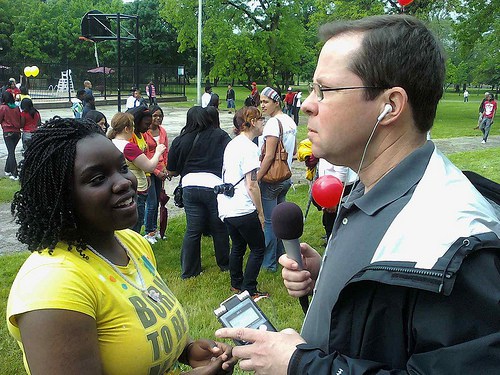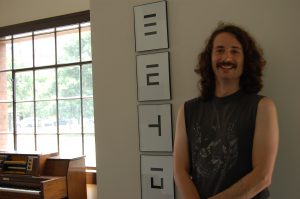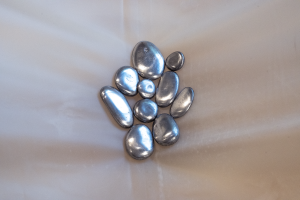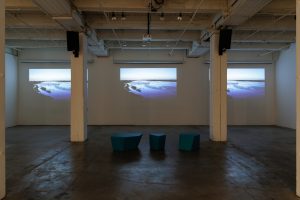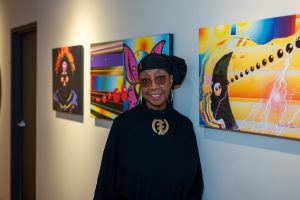Imagine a world where art and education are put at the top of everyone’s agenda.
Now, imagine the taxing effort it would take to get to a place where such a thing existed in America. Jim Duignan puts that kind of initiative at the forefront of his agenda with an “all-of-the-above” and “do-it-yourself” mentality.
Duignan spearheaded projects like Nomadic Studios and founded The Stockyard Institute. Not only does Duignan put forth radical amounts of free-to-the-public programming in Chicago, he also pushes these initiatives nationally and internationally. Aside from all of the projects and collaborations he has either created or participated in Duignan is also a professor at DePaul University.
Jim Duignan put some time aside for an in-depth interview explaining a great deal about how his career began, his philosophies and current projects.
Nicolette Caldwell: How long have you been living and working in Chicago?
Jim Duignan: My whole life. I graduated from Taft HS in 1976 and did my BFA and MFA at University of Illinois at Chicago.
NC: When did you decide you wanted be an educator and what is your current role?
JD: I am an Associate Professor of Visual Art. I am chair of the Visual Art Education Program in the School of Education at DePaul University. I thought about teaching in high school – Sam Wenet was my art teacher at Taft High School and was the first individual who portrayed the possibility to me. I don’t remember thinking about it quite the same way before I meet him.
NC: When did you decide to start doing educational outreach?
JD: That was an early conscious idea where “educational outreach” (for lack of a better term) moved through an arts practice. This was in graduate school. I was doing an MFA in Studio [Art] at University of Illinois at Chicago. I wanted to show my work where I hung out; the gallery circuit was less interesting to me. I would have rather built my own spaces to show work, talk with folks, help small groups and young artists, all within a singular site, than accept gallery invitations. I wanted to explore pedagogy from a social practice that included my studio work. I still feel that way and, in fact, I have been able to build those spaces over and over again around Chicago neighborhoods. I would see the Stockyard Institute as simply a contemporary artistic practice but I got wrapped up to the force of Jane Adams. Her model of the social settlement as an artistic practice appealed to me because of how I had identified my priorities.
 I was investigating Chicago stories over a lifetime of listening and imagining. I found myself talking to all sorts of people and intersecting with projects and a small handful of activists as I roamed Chicago neighborhoods. My thoughts on pedagogy appeared to mirror many people’s approach that I met who were working with community residents, incarcerated youth, homeless students, and gang bangers. There was a symmetry to early discussions I had with a range of individuals and local folk heroes: Saul Allinsky and Jane Adams were mentioned in the same breadth as Axe Street Arena, The Resource Center, and small community arts spaces and projects like early Street Level Video block parties, and cool projects and programs emanating from park district field house, out buildings, local libraries, and non-traditional school-like spaces.
I was investigating Chicago stories over a lifetime of listening and imagining. I found myself talking to all sorts of people and intersecting with projects and a small handful of activists as I roamed Chicago neighborhoods. My thoughts on pedagogy appeared to mirror many people’s approach that I met who were working with community residents, incarcerated youth, homeless students, and gang bangers. There was a symmetry to early discussions I had with a range of individuals and local folk heroes: Saul Allinsky and Jane Adams were mentioned in the same breadth as Axe Street Arena, The Resource Center, and small community arts spaces and projects like early Street Level Video block parties, and cool projects and programs emanating from park district field house, out buildings, local libraries, and non-traditional school-like spaces.
NC: How did those interests and experiences end up manifesting?
JD: I started the Stockyard Institute in 1995 to create my own space and do what I wanted to do with whom I wanted, the way I wanted. It was a high school idea of building my own art school for the conscious.
NC: What is your role with the Stockyard Institute?
JD: I still manage big projects and do what I want. But I have a core group of teachers, artists, writers, and musicians who have clear expectations for arts education, public work, publications, performance and how we use the city of Chicago. There is a team of us working on many projects together. There has also been, for some time, a large network of people and friends who assist with everything from mounting shows, collaborating on events, working on publications and international work, in the form of school / university-like and residency structures.
 NC: Who benefits from Stockyard?
NC: Who benefits from Stockyard?
JD: My intent early [on] was that this was an artistic practice that could imagine youth as the primary benefactors. I probably benefit more than anyone. It is still very satisfying.
NC: How can someone take advantage of the programming there?
JD: Come see me.
NC: Does it cost anything?
JD: No, everything is free.
NC: You talk about radical pedagogy quite often. What is your idea or concept of that and how do you insert that into your teaching philosophy and your outreach initiatives in Chicago?
JD: Pedagogy is grounded in much of the Stockyard Institute’s effort with groups [teaching] and writing [curriculum] and exhibitions [projects.]
My diatribe on radical pedagogy is two-tiered and stems from a deficient stake schools claim on teaching, compounded by a history of proof of that deficiency. I feel that youth in Chicago are impoverished by a small selection of tools to interpret their experiences, as Maxine Greene rallies with such precision, honesty and sensitivity. There is a movement, a dangerous swell from the ground to narrow the capacities of young people. With only a few structures (writing, speaking, talking) to unravel and process, complicated and developing understanding of the world will only diminish the school experience as the crudest model of the public education factory. There is a lack of performance and any hope of innovation or invention cannot grow in a system that champions simple outcomes to a handful of civil subjects that exercise the lowest common denominator as a singular expectation. It is embarrassing.
NC: The Stockyard has been around for some time now and you have completed much successful programming. Clearly it is an ongoing progressive development and there is no real ‘end’ for the initiative that you have pursued with Stockyard. But do you feel you have accomplished what you were hoping to at this point? What are your thoughts about the progression of your educational initiatives?
JD: It is always about starting and experimenting and starting again. When I think of the youth and even young artists I worked with, I am satisfied to some extent. However, I am never satisfied really. The youth in the city should have ideal spaces to work out their ideas and connect to those who can help them. It is a Hull House model. We need more models, and Chicago is poised to organize this work. People don’t really know how to talk about the Stockyard Institute within an art world or education environment.
NC: You worked on a project called Nomadic Studio in conjunction with Studio Chicago last summer. Could you tell me a little bit about that project and what the programming looked like?
JD: Stockyard Institute curated the project Nomadic Studio not as a replica of the structures we use, but a public studio for people at the university and in the community to use—a space for those who needed a site to make work. There was about 40 programs and smaller events throughout the five month exhibit that housed an office, studio, performance area, exhibition spaces, a rumpus room and a public university radio station.
The programs were designed to introduce the public to the day-to-day functions of local writers and critics, and community printmakers [and] recording engineers, food artists and musicians. A panel came together and was often organized by someone in the field who fit somewhere between the social practice sector and the network of like-minded folks who came to share their work. Half of the museum changed as monthly themes reintroduced some focus towards and hovering over local music, community history, collective content, and arts teaching.
NC: Are you satisfied with the turnout?
JD: Once a project of this scale is up, some aspect of the work is complete. We worked on it for a year. The turnout is incidental to me. I am happy when I see young people come together and meet one another, setting up future work or building from what started in our space. There was a rather significant amount of people who walked through the museum.
NC: What would you have liked to do differently?
JD: There is always something you learn.
NC: What were some of the best experiences coming out of that project?
JD: Working with Beth Wiedner and Faiz Razi on the daily organization, writing, and installation. Having such different backgrounds and abilities, as we three do, set up the ideal condition for an engaged, dynamic and interactive space. It was truly a group or ensemble effort. Faiz has an enormous reach in the music world that both his concepts for monthly performances and improvisational work elevated the physical space and connected musicians and artists to each other’s work and lives. Beth is a producer who has one of those brains for orchestrating impossible projects with such precision and good will. Projects we have been accustomed to that have so many pieces. Keith Brown joined the project at two critical points at the start and end, providing pedagogical resources, the kiosk of digital documents, and artists who contributed to the overall scope of the exhibit. Working with these three was the finest part of the experience.
 NC: What projects are you working on right now?
NC: What projects are you working on right now?
JD: I just finished an exhibit in New York and Houston. I am writing a few things, now a piece on the Peace Warriors, a group I am working with in Lawndale, which will be published in SPEAK UP in Denmark this year. There are some catalogues and books to complete individually and with the group, working on a ‘big arts’ and education space in Omaha and some large scale curriculum efforts with Beth Wiedner, Faiz Razi and Keith Brown called SITE, which hopefully will splinter its influence towards another project or two of a similar nature. That connection or joining of the projects would work more effectively and efficiently by allowing all the effort to come together from one camp with one focus.
NC: Are there any future projects in the works?
JD: In the near future, “Version: The Community”, in April; and I hope Chicago comes out strong. I recently worked with a group at the Grand Arts in Kansas City called the Print Factory and will try to get them into town to work with us at “Version.” Stockyard Institute will be there with some of our friends on Saturday and Sunday the 23rd & 24th of April. There is much activity in 2011 and I would like to find someone who could layout a very graphic based book.
NC: What do you think about the recent mayoral election?
JD: I will have to see. I am not very clear on this administration’s commitment to youth.
NC: Do you see a ray of light paving the way for the city to increase funding and increased supplemental support for the arts in Chicago?
JD: I make my own light.
NC: How have your projects and recent collaborations affected those experiencing them?
JD: I hope, positively. It shouldn’t be a mystery that I bring people towards me that I want to work with. I think that is natural. I am committed to helping [young] artists make things happen or continue to find spaces to work and connect them to others. It is what I look for, as well.
The social practice of my efforts is comprehensive. It extends to every level of these human experiences including the shape of the work. I hope collaborators take that away, that sense of support and mutual engagement from the experience. That engagement with others informs my practice and my love for the artists and non-artists who work at street level. I like hearing what people are doing in Chicago. I am very interested in how they design projects and persevere and channel their ideas to a host of sources. This is critical if you want to keep artists here. Chicago can be a great place to work but young artists need some help in building their own network. I am grateful to so many individuals and groups here, a constellation of creative folks around Chicago who help one another. It keeps me going and strengthens our collective spaces.
 NC: What are your thoughts on art in the institution in comparison to, for example, the mission of Sixty Inches From Center which is, “to document, archive and support art that exists outside the central iconic art institutions in Chicago?”
NC: What are your thoughts on art in the institution in comparison to, for example, the mission of Sixty Inches From Center which is, “to document, archive and support art that exists outside the central iconic art institutions in Chicago?”
JD: Like I said, I have always wanted to show my work where I hung out. Taft High School was the first site in some way. It just felt right and still does many years later. I would like to have an exhibit at Taft High School someday. That prospect would intrigue me.
I grew up in Chicago and have always felt that I could work anywhere. Galleries and museums in Chicago provide one option for artists, spectators, and supporters to think about the artist and their work. It is an introduction for young artists coming into their own to establish a relationship with that work and to locate methods for alternative considerations to the form.
Artists working in Chicago understand that we have so many options or forms today and have become a Midwestern center for those options and how they work. Apartment galleries and temporary undergrounds, to experimental multi-use sites, to established socially engaged hubs, have been firmly linked to this city. And yes, this is a draw for me, and a place I move around in. There is an extraordinary quality and depth in the work I see and support in the quieter quadrants of the city. It is being recognized as some socially engaged work and elements of pedagogy find a way into local contemporary art exhibitions and the dialogue that hovers over it. I wish that someday this street level work finds its way into our local schools—not as a representation of what is happening in this city, but the early focused education and study its deserves.
It seems perfect that Sixty Inches from Center has surfaced now. SIFC can contribute to authoring the catalogue of the city’s finest work and establish those connections I find so important between artists and spaces, projects and opportunities. JD
